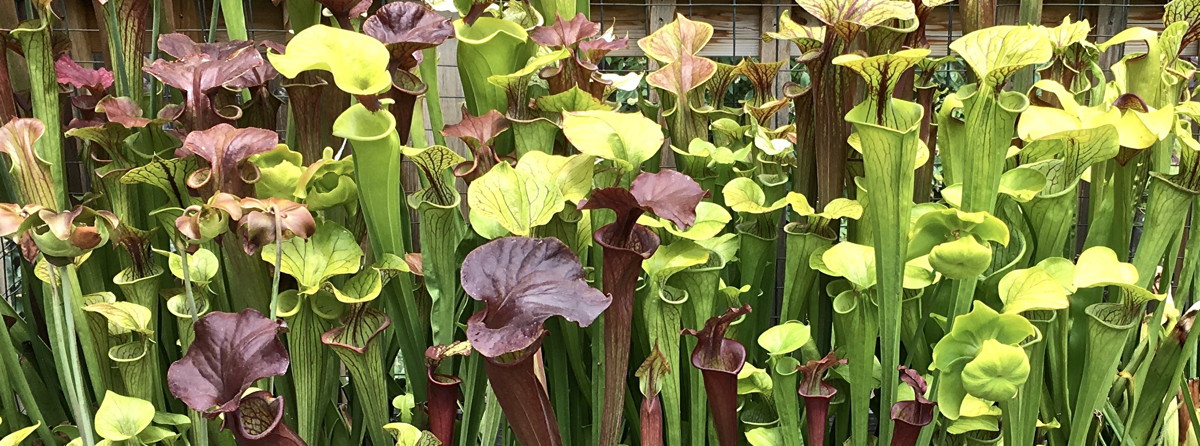
Sarracenia are among the easiest carnivorous plants to grow. If you have a location outside with full sun and have or can easily get water low in minerals there is no excuse not to grow these spectacular plants. If you do not have a full sun location outside there are certain Sarracenia species that can be grown indoors under lights.
The genus Sarracenia consists of 15 species and subspecies found naturally only in North America. All but one of those taxa are restricted to the southeast USA with the epicenter of the genus on the coast of the Gulf of Mexico. The taxa restricted to the Gulf coast are considered warm temperate. That is they expect seasonal changes but do not handle freezing weather and short growing seasons very well. The taxa found naturally inland or along the Atlantic coast, Virginia south, are more cold temperate. They do not require freezing temperatures but do naturally get them in the wild. They also are more tolerant of shorter growing seasons. Sarracenia purpura subsp. purpura, which is found in the northeastern USA and southern Canada, is very cold temperate but does well in areas with moderate winters. There are thousands of Sarracenia hybrids each with its own growing preferences.
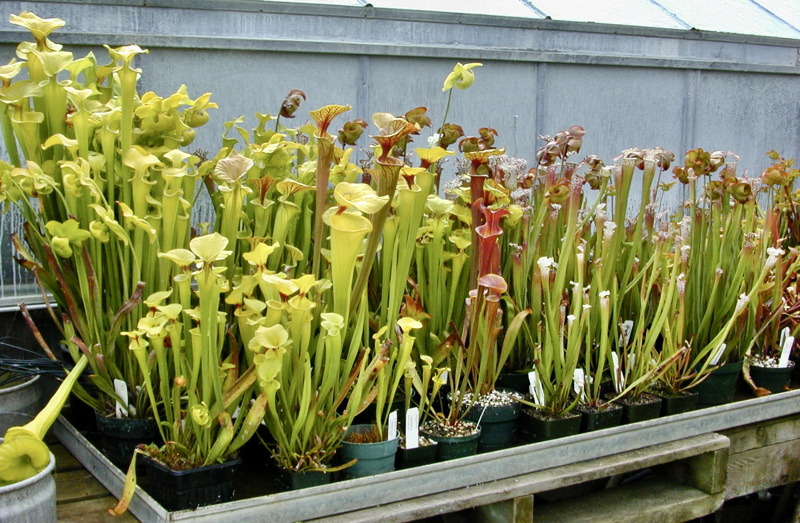
Sarracenia planted in pots growing in a galvanized steel water tray. The tray is topped up with water every morning during the growing season. It is never allowed to dry out. The plants are at table height which allows easy access and viewing. This sort of tray works great year round in USDA zones 9 and warmer. In USDA zones 8 and colder the plants in pots should be snugged together on the ground during the winter.
Some species such as Sarracenia psittacina, S. rosea, and most S. minor types are best adapted to long growing seasons and mild winters as occur along the Gulf Coast between Texas and northern Florida. S. psittacina in particular is freeze sensitive. The Sarracenia rosea and S. minor are all fully hardy to USDA zone 8. The other Sarracenia species are fully hardy to USDA zone 7 although some Sarracenia leucophylla clones may need protection. It is the early and late freezes that can be deadly. The plants in pots will survive a few weeks frozen solid if they are fully dormant and do not freeze-dry. Snow works as a great insulator for plants. If it snows, shovel extra onto the plants to protect them from the cold.
In USDA zone 6 it is best to concentrate on plants from the Carolinas and highlands such as Sarracenia flava, S. oreophila, S. jonesii, S. purpurea subsp. purpurea, and hybrids containing those species. The plants are best grown in artificial bogs in the ground and heavily mulched and/or covered with row cover during the winter (please see Growing Carnivores in Canada). If there is a surprise early or late freeze with the plants unmulched, put row cover over them.
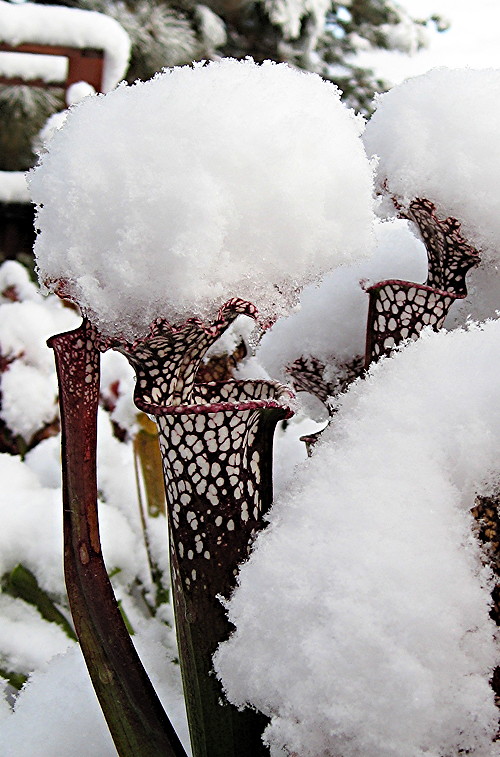
Sarracenia leucophyla with snow hats. Snow is a friend of Sarracenia because it protects the plants from extreme cold. Pile snow on base of the plants. Snow hats are for fun.
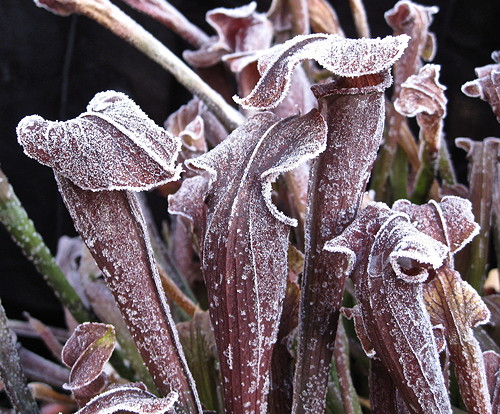
Sarracenia jonesii with hoarfrost at -7°C (19°F). The plants were not harmed in the least because they were fully dormant at the time.
In USDA zone 5 and colder your only option for plants outdoors year round is Sarracenia purpura subsp. purpura. Other Sarracenia species in pots can be overwintered in cold greenhouses as well as cold frames, unheated garages, unheated sun porches, and even basements. It is important the winter storage location is cool to cold since if it is too warm the plants can start growing prematurely and have trouble with the transition to outdoors in the spring.
Sarracenia appreciate long growing seasons and warm to hot summer temperatures. In areas with short growing seasons or cool summers it is helpful to have plants in a greenhouse or hoop house. In areas with very hot temperatures and low humidity you might have trouble with the pitchers burning. Some afternoon shade can help.
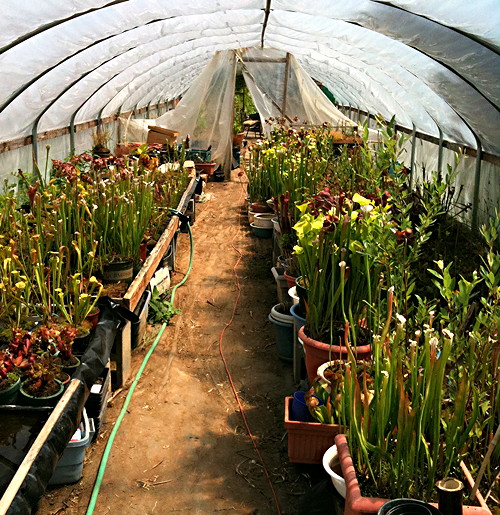
Growing Sarracenia in a hoop house in USDA zone 7. The hoop house allows the plants to get a one month head start in the spring on plants grown outside and extends the growing season farther into the fall. It can be quite hot inside during the summer. Snow on the roof can be a problem.
Sarracenia psittacina and S. rosea are the species recommended for growing indoors under lights year round. These species along with Sarracenia leucophylla make great heated greenhouse plants. All other Sarracenia can be grown in greenhouses in areas with inadequate summer heat. It is difficult to grow the tall species under lights unless you use mirrors or other reflective material to get light to sides of the tall leaves.
There are tradeoffs for when Sarracenia leaves should be trimmed back. The plants recover nutrients in old leaves to use with new growth. Cutting off green leaves can starve a plant that lacks a large rhizome. Except in special circumstances it is best only to cut off the brown part of leaves. One of those special circumstances is storing plants in a garage, basement, or coldframe over winter. Old leaves not exposed to the elements can harbor pests or reduce air circulation inviting fungus and other problems.
The long tube Sarracenia varieties that are stored in a protected location during the winter should benefit from a haircut in the fall because of the lack of air circulation. Plants over-wintered in a deep pine needle mulch may need some of the leaves thinned out. Plants outdoors unprotected are best left fully exposed to rain and snow with only dead leaves and brown leaf ends removed unless there is a dense thatch of leaves as is common in the Sarracenia rubra complex. When the plants begin to grow in spring, it helps to remove the tops of old pitchers and any leaf parts that can snag flowers scapes and new leaves.
Sarracenia purpurea, S. rosea, and S. psittacina should only have their pitchers removed when they turn brown. Individual pitchers of these plants can last up to two years.
Although Sarracenia are fen plants where water moves through the soil, they can be grown in the ground in artificial bogs made from molded plastic pond shells, plastic sheeting, or pond liner. Although the plants do not mind total immersion for short periods of time, it is best to keep the water level 7 to 18 cm (3 to 7 in) below the soil surface and to add water to the bog on the side opposite to the drain.
The most common way to grow Sarracenia is in pots sitting in water. For mature specimen plants, pots 16 to 20 cm (6 to 8 in) wide work best. The pots should always be sitting in about 4 to 6 cm of water. Sarracenia should never be allowed to dry out. The pots can sit in standard plastic plant trays, metal trays, or trays constructed with rot resistant wood and black plastic or pond liner. It is best to have an automatic watering system so watering your plants does not become a chore and you do not have to worry about being away from home.
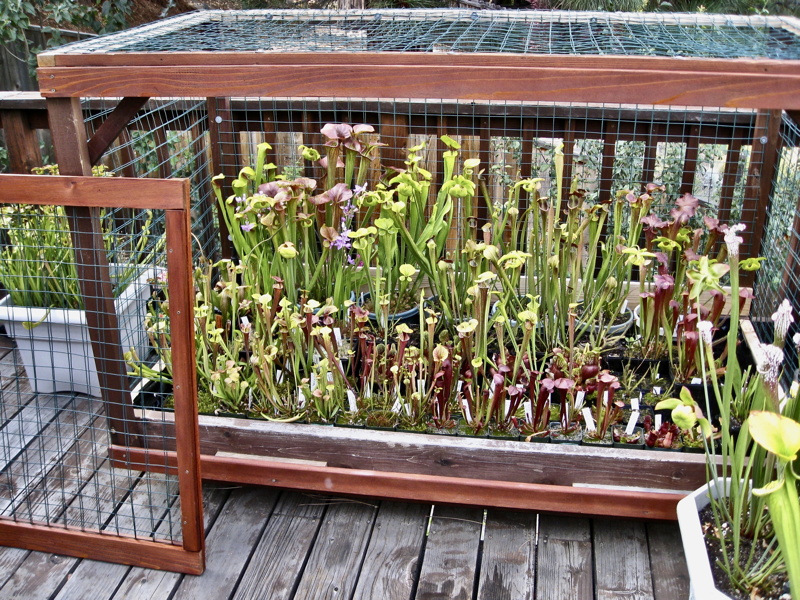
A Sarracenia water tray and cage made to keep out squirrels and raccoons. Squirrels and raccoons will trash your plants if given the chance. They are attracted to standing water and to live Sphagnum moss.
The default soil for Sarracenia is standard 1:1 peat:sand CP mix. For plants outdoors where they get plenty of water to flush the soil, perlite can be substituted for sand. Some clones of Sarracenia purpurea subsp. purpurea and S. minor may do better in live sphagnum while S. psittacina likes pure peat and short pots.
There is little benefit to soil fertilization of mature Sarracenia. Fertilizer in contact with dead plant parts like old leaf bases can encourage rhizome rot. Putting fertilizer water in long tube pitchers can also be counterproductive. The plants pump the fertilizer water into the soil resulting in effective soil fertilization. Sarracenia purpurea complex plants like water added to their pitchers and do benefit from some fertilizer in the pitchers. It is effective to make a slurry of dried blood worms (fish food) and put that into the pitchers--too much may burn the pitchers. In general, it is best to make sure your plants get as much sun as you can give them and that they have access to prey.
-- John Brittnacher
July 2013
Last Update June 2019
For more information please see:
Display Sarracenia on your deck with plants that can be mistaken for flowers in big pots.
Growing Carnivores in Canada the secret is in-ground bogs.
Pacific Northwest Bogs help the plants over-winter better and look nicer during the summer.
Growing Sarracenia from Seed is easy.
Dividing Sarracenia Step-by-Step is necessary every 3 or 4 years for well grown plants.
Sarracenia Soil Fertilization is only for seedlings.
Sarracenia Rhizome Rot is what you get when you fertilize adult plants, use salty water, or have a local source of certain fungi.
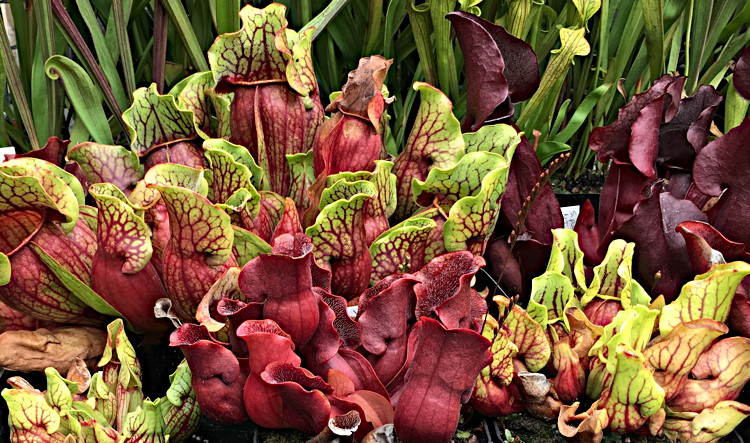
Four types of Sarracenia purpurea. Upper left: Sarracenia purpurea subsp. purpurea from Ontario, Canada. Upper right: a deeply colored Sarracenia purpurea of indeterminant type from the New Jersey Pine Barrens. Lower right and lower left: Sarracenia purpurea subsp. montana from Transylvania County, North Carolina. Lower center: Sarracenia purpurea subsp. venosa. All are blooming size.
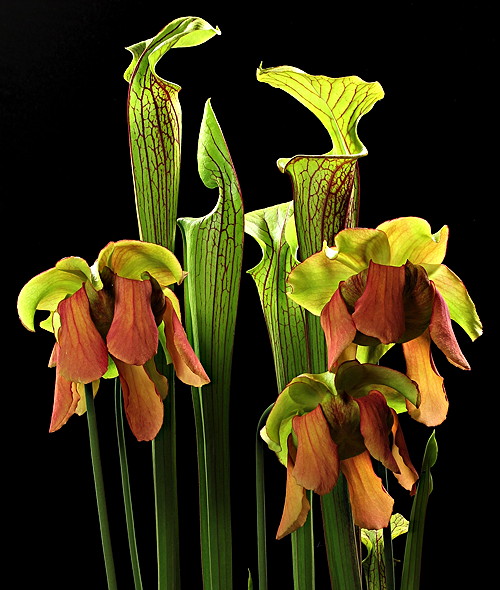
A Sarracenia complex hybrid with orange flower petals. Some people confuse this plant with the non-hybrids Sarracenia flava var. ornata and Sarracenia flava var. rubricorpora depending on how dark the pitcher tubes get any given year.
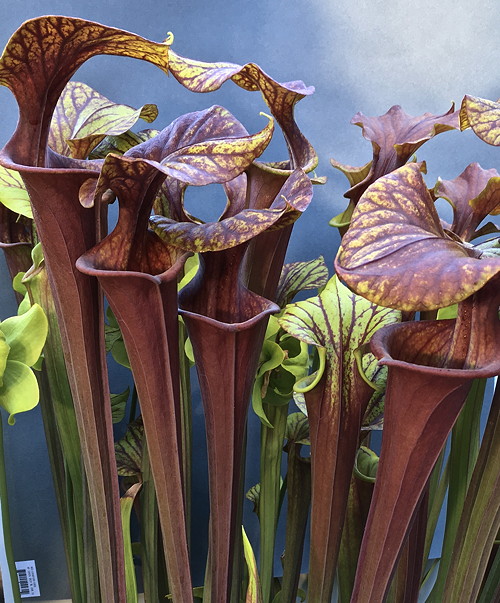
A red tube Sarracenia flava with pitcher lids that open green and slowly turn red. This could be considered a Sarracenia flava var. rubricorpora or a hybrid Sarracenia flava var. rubricorpora X atropurpurea.The pitcher lids of Sarracenia flava var. atropurpurea open red and are usually darker than the pitcher tubes.
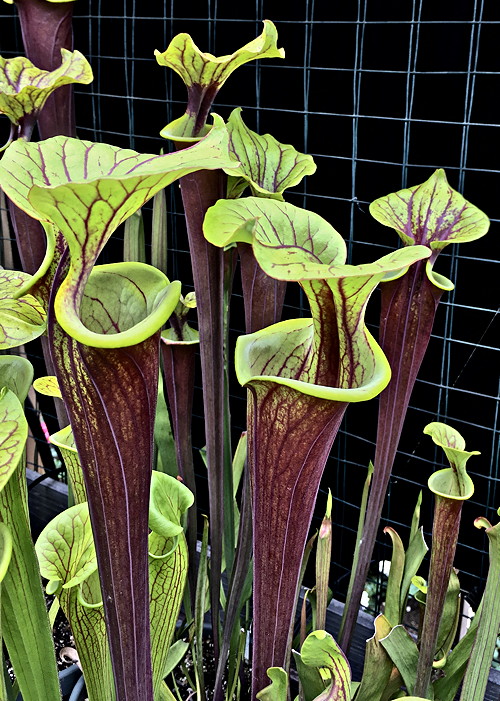
Sarracenia flava var. rubricorpora.
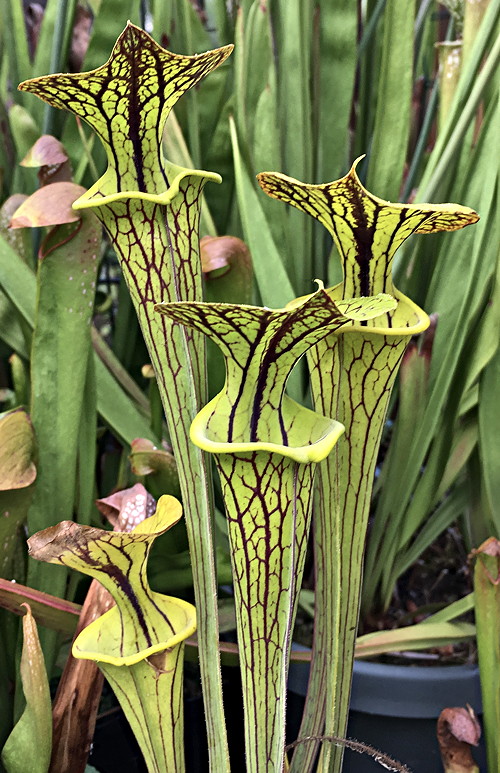
Sarracenia flava var. ornata with black veins.
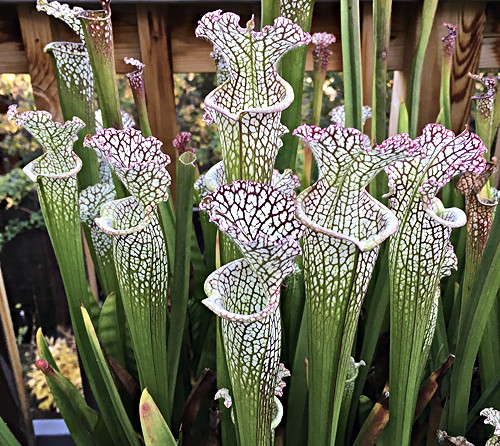
The fall pitchers of Sarracenia leucophylla.
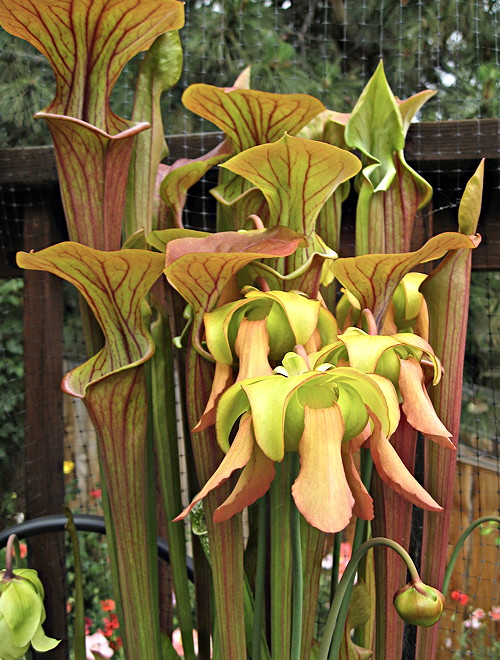
A Sarracenia hybrid with a lot of Sarracenia flava var. atropurpurea and Sarracenia oreophila var. ornata heritage. The flowers say there is a something else with red flowers slipped in.
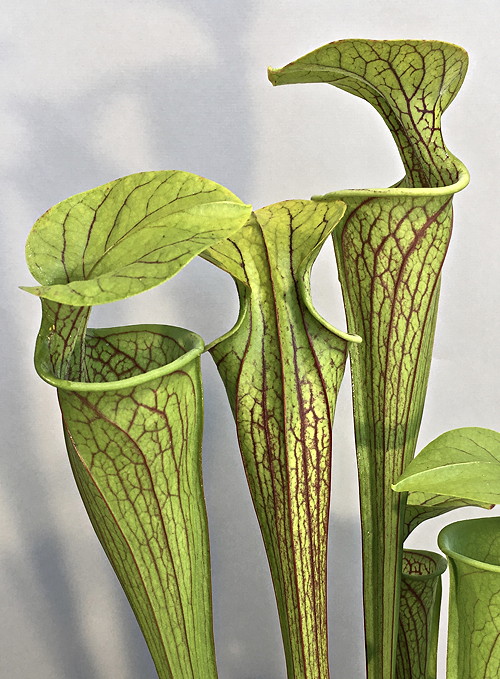
Sarracenia oreophila var. ornata.
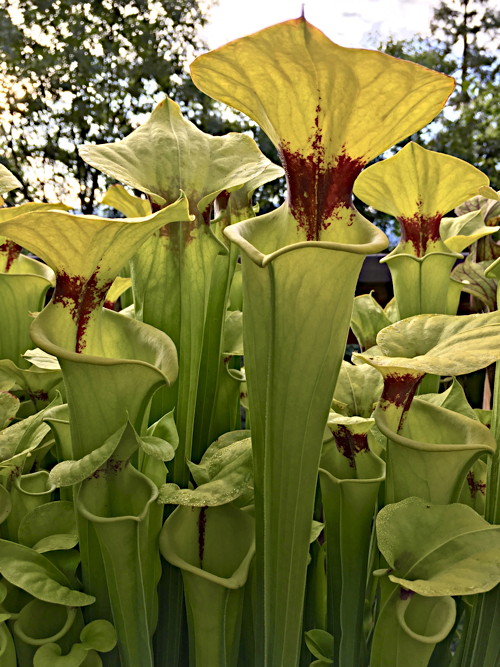
Sarracenia flava var. rugelii.
